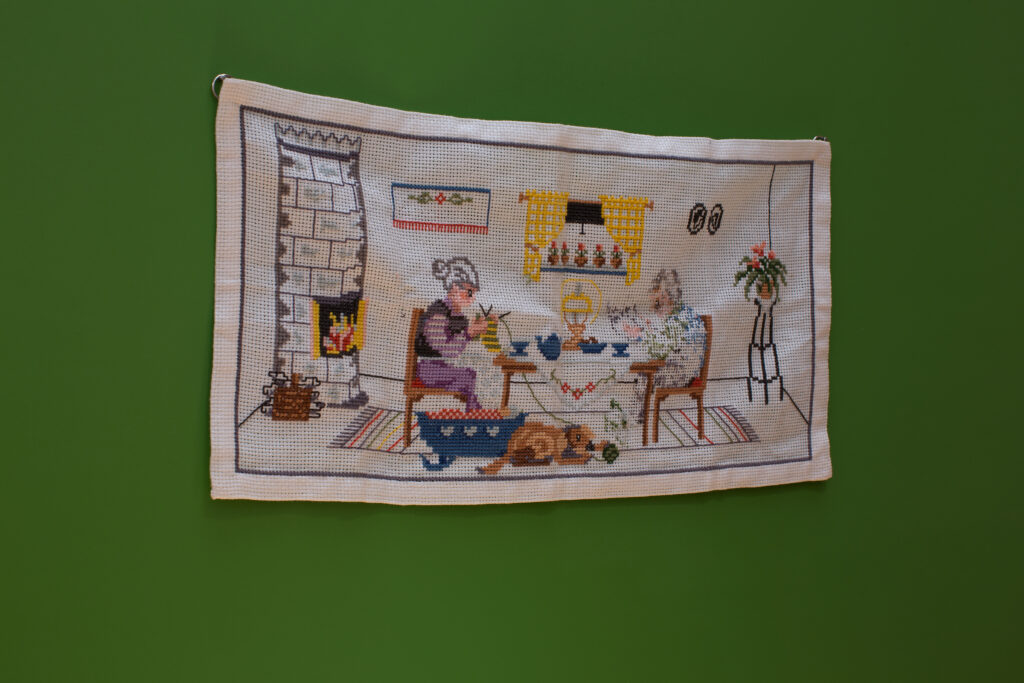
“Urmas Lüüs is an Estonian artist working in the fields of jewellery, sculpture, installation, writing, music and theatre.” That’s the short explanation on the artist’s website. Embroidery, video and photography can be added to the list of permanent media with which he is familiar. Lüüs’s diverse artistic practice is based on a material mystery physically embedded in everyday objects, often beginning with an obsessive process of accumulation. For example, his last solo exhibition at the Tütar Gallery in 2023 was based on over 7,000 photographs taken in cemeteries. The exhibition Man! God Has Created You Out of Nothing, and This is Too Often Felt in Your Case focused on Catholic funerary culture.
As an artist on the theoretical horizon of neo-materialism, Lüüs inverts the most important principle of conceptualism, which states that “thought should be more intense than the force of its embodiment”[1]. The credo of Lüüs is reflected in the belief that the artistic text is kept in operation by the energy of the personal poetic manipulation of the material. At the most general level, this implies a conscious opposition to the dominant patterns of behaviour of both the industrial production society and the service-based information society. The medium/genre dialogues that characterise Lüüs derive from the arsenal of practical craftsmanship of the applied artist. The system is based on the eloquence of a seemingly useless decorative gesture.
As an artist, Lüüs has an uncanny enduring relationship with the aesthetic of saturated poverty. In his case, it ranges from the imagery of religious kitsch in Catholic cemeteries to dusty souvenir horns on the walls of hunting lodges; and from tasteless nature images made from amber shards to Richelieu embroidery. His relationship with these object worlds, picked up from the peripheries of our aesthetic focus, is anything but nostalgic-sentimental camp. It is characterised by the retroactive excitement of the lived-through, collected and piled-up material into grotesque images and witty stories.
Lüüs’s imagery, presented as a sculptural detail, can take on a new life as an element in a photo or a video, or in his installations and physical theatre performance. A good example is the heart motif: it is expressed in a giant 35-kilogram iron heart that leaves brutal sores on the body after only half an hour of wear, and in the porcelain heart-shaped bottles he uses in the video Mortal Kombat: Love (2016) as Molotov cocktails, throwing them against a flaming wall. The same heart, albeit in a new physical incarnation, comes back into play as an object in his latest installation show at the Tütar Gallery. Operating in the liminal space between jewellery, embroidery and sculpture, the motifs find new places in Lüüs’s open but over saturated art system in a constant cycle. The same happens with the video in the exhibition Yet Another Example of the Porousness of Certain Border, whose motif of a figure blindly putting on make-up on a pillowcase floats to the surface once again with new connotations in the second scene of the stage play Aunt Õie’s 65th Birthday. Every object and gesture has its own possible afterlife.
The exhibition Yet Another Example of the Porousness of Certain Borders (2021) consisted of objects left behind by Lüüs’s grandmother, who had passed away, in which the artist participated as a dialogue partner. For example, the work These Were Confusing Times was based on his grandmother’s doily with liverwort embroidery. The artist added the text “These were troubled times. It’s a troubled time”, taken from an interview his grandmother gave to Lääne Elu newspaper in 1988. Once again, Lüüs’s creative system was at work, branching out at once into individual works and complete installations.
Something close to this is also happens in his object-based stage productions. For example, the installation environment Overcrowded Loneliness – a frozen second from an imaginary performance – created for the Sõltumatu Tantsu Lava in 2022, was based on the everyday environment of a fictional elderly woman. Temporary walls divided the stage into zones, which the spectators passed through as a total installation environment. The meditative objects encountered on this journey created a choreographic experience. The smaller works presented in Lüüs’s installations and productions seem to be characterised by the principle of sacramentality: the invisible and spiritual is present through the visible and material, which in turn becomes sacred through its presence.
In the spring of 2023, Urmas Lüüs and Hans-Otto Ojaste took over the cramped spaces of the Hop Gallery with their Kabakovian installation An Owl Screamed and the Samovar Hummed Without Stopping. The work was intended as an imaginary encore of Anton Chekhov’s play The Cherry Orchard. If the textual dimension of the installation remained a behind-the-scenes fantasy for the viewer, its physical presence was all the more compelling. The journey of the viewer through the claustrophobic maze of brown cabinets from the Soviet era was accompanied by souvenir horns, electric light bulbs and ghostly swirling fan blades that seemed to belong to an abandoned hunting lodge, and had broken their way through the cabinets. The motifs of vanitas and still life dominated in all their eerie aspects.
Aunt Õie’s 65th Birthday (2024) was the artist’s first production with actors. It worked with background texts, which were originally intended only as a means of fleshing out the character and contemplating her motives for action. The short novella-like stories, which the audience could listen to while they waited to be ushered into the birthday party, formed a collection of anecdotes almost the size of a book. It is in this cumulative way that Lüüs continues to create new parallel worlds in his creative system.
Hanno Soans
[1] Thurlow, Vappu. “Salapärane performance,” Lähenemised. Kunstitekstid ja näitused 1988–2001, 2006. pp. 50–56.
Urmas Lüüs is a graduate of the Estonian Academy of Arts, specialising in jewellery and blacksmithing (BA, 2011; MA, 2014). He has been awarded the Roman Tavast Prize (2010), the Young Jewellery Scholarship (2014), and the Annual Award of the Cultural Endowment of Estonia (2024, together with Hans-Otto Ojast).